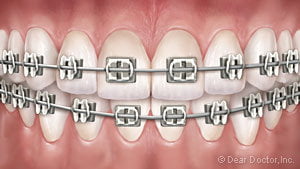Traditional Braces
Healthy teeth can be moved at any age, so there’s no such thing as being too old for braces.

Permanent vs. Temporary: What’s the Difference?
It’s essential to differentiate between permanent (fixed) and temporary (removable) orthodontic tools. Permanent devices, such as braces, are either bound to teeth with metal bands or adhered using special cement and stay put until the treatment concludes.
In contrast, removable tools like clear aligners, are generally worn around 22 hours a day but can be taken off whenever required.
While clear aligners can address mild to moderate dental misalignments, for more intricate treatments, fixed appliances usually take the stage.
Traditional Metal Braces
Constructed from premium stainless steel, the conventional metal braces continue to be the most prevalent fixed orthodontic tool. These consist of metal bands encircling the back molars and tinier brackets glued to the fronts of other teeth.
A flexible metal wire threads through these brackets, gently steering teeth to their ideal position, often held in place by elastics or metal ties.
Today’s metal braces have evolved from their predecessors. They’re sleeker, lighter, and far more comfortable. For those seeking a dash of flair, colorful elastics or other personalized touches might be an option.

The Elegance of Ceramic Braces
Introducing a less conspicuous counterpart to the conventional system: clear ceramic braces. These employ similar components as the classic braces, except the brackets are made from a translucent ceramic, harmonizing with the natural tooth shade. This camouflaging feature has made them a popular choice among adults, including some renowned faces.
With ongoing advancements, several ceramic brace variants are up for grabs. While their aesthetic charm is unmatched, there are certain considerations. Ceramic brackets may not be as sturdy as metal ones. Although the brackets resist staining, the elastics connecting them might not (though they are frequently replaced). Also, ceramic braces come with a slightly higher price tag, but for many, the discrete appearance justifies the expense.

The Secret of Lingual Braces
For those prioritizing invisibility, lingual braces might be the answer. These special braces are strategically placed behind the teeth, making them genuinely hidden from view. Constructed from metal, they function similarly to traditional braces but remain unseen as they’re tucked behind the teeth.
However, lingual braces aren’t universally suitable. Installing them necessitates specialized training, they come with a heftier price tag, and they might take some getting used to. They could also extend the treatment duration slightly. But for those eligible and keen on the most discreet fixed solution, lingual braces could be the perfect fit.

Related Articles
Read about helpful topics
Proper alignment of the teeth is basic to “Smile Design.” Their position dictates how they work together and affects the way you look and smile. Only orthodontic treatment can move teeth into the right position. Simply put, when things look right, they probably are right. Learn the basics of smile analysis and design and whether the magic of orthodontics will work for you… READ ARTICLE
Moving teeth orthodontically is a fascinating process by which the bone that surrounds and supports teeth is gently forced to remodel itself. Orthodontics moves teeth with a careful manipulation of force that guide the teeth into a new, improved position and better equilibrium. Light, constant forces applied to the teeth allow them to move in a predictable manner and direction… READ ARTICLE
Teens who regard traditional braces as restrictive, confining, and obstructive to their lifestyles now have another choice for orthodontic treatment: clear aligners. This advanced dental technology, originally geared toward adults, has recently evolved to treat a greater variety of bite problems in younger people. These improved orthodontic appliances can help teens function normally during a difficult phase of life… READ ARTICLE


